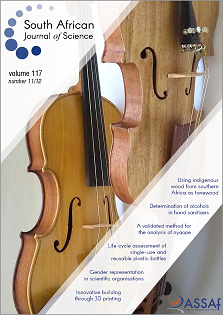Determination of alcohols in hand sanitisers: Are off-the-shelf hand sanitisers what they claim to be?
DOI:
https://doi.org/10.17159/sajs.2021/9328Keywords:
alcohol contents, ABHRs, COVID-19, SARS-CoV-2, homemade hand sanitisers, gas chromatographyAbstract
Transmission of SARS-CoV-2 – the causative agent of COVID-19 – can be prevented through non-pharmaceutical interventions such as observing proper hand hygiene using alcohol-based hand rubs/sanitisers (ABHRs) as recommended by the WHO and local health authorities. However, this recommendation has led to high demand for ABHRs and proliferation of sub-standard products, which do not contain the recommended amount of alcohol. Fifty products of different origins and formulations obtained off-the-shelf and in public places in and around Pretoria (South Africa) were analysed for their alcohol content using gas chromatography. Ethanol was the most common alcohol used in the products, followed by isopropanol. Only 21 (42%) of the products analysed contained at least 70% alcohol; of these only 14 (28%) met the WHO recommended 80±5% alcohol content to have a virucidal effect on SARS-CoV-2. Of the 41 commercial off-the-shelf products analysed, 27 (66%) contained less than 70% alcohol in comparison to 13% of homemade products. Only 18% of gel products contained 70% alcohol, compared with 47% for liquid-based products. Most of the products did not contain the appropriate or correct declaration as recommended by the South African National Standards (SANS 289 and 490). The proliferation of substandard ABHRs is of great public health concern and calls for stricter regulations and enforcement in order to protect consumers, their rights and well-being during and post the COVID-19 pandemic period. However, in the interim, formulation of ABHRs using the WHO guidelines should be mandatory, as such formulations, when made correctly, do have the required virucidal effect against SARS-CoV-2.
Significance:
- Commercial, off-the-shelf and public hand sanitisers were analysed to determine whether they contained enough alcohol to be efficacious virucides as recommended by the WHO.
- The majority of the products analysed were substandard, did not contain the recommended amount of alcohols and were not labelled correctly according to local and international standards.
- Homemade products conformed to a greater degree to the WHO standards for alcohol-based hand sanitisers. It is evident from these results that there is a need to monitor the manufacture of off-the-shelf products to ensure compliance and to assure consumers that products offer the required protection against SARS-CoV-2.
Published
Issue
Section
License

All articles are published under a Creative Commons Attribution 4.0 International Licence
Copyright is retained by the authors. Readers are welcome to reproduce, share and adapt the content without permission provided the source is attributed.
Disclaimer: The publisher and editors accept no responsibility for statements made by the authors
How to Cite
- Abstract 1462
- PDF 849
- EPUB 250
- XML 247













.png)